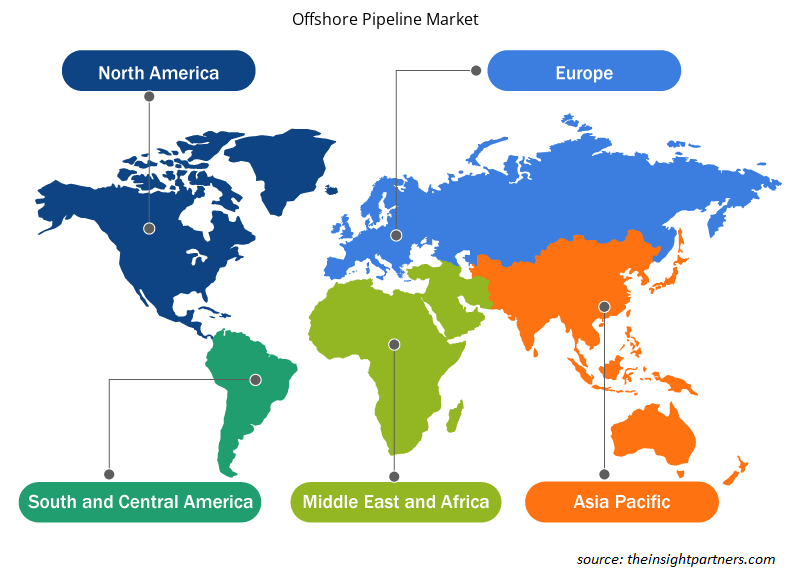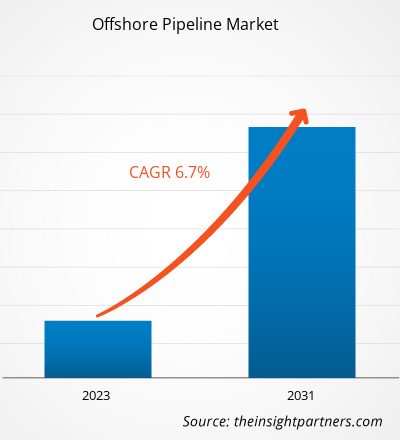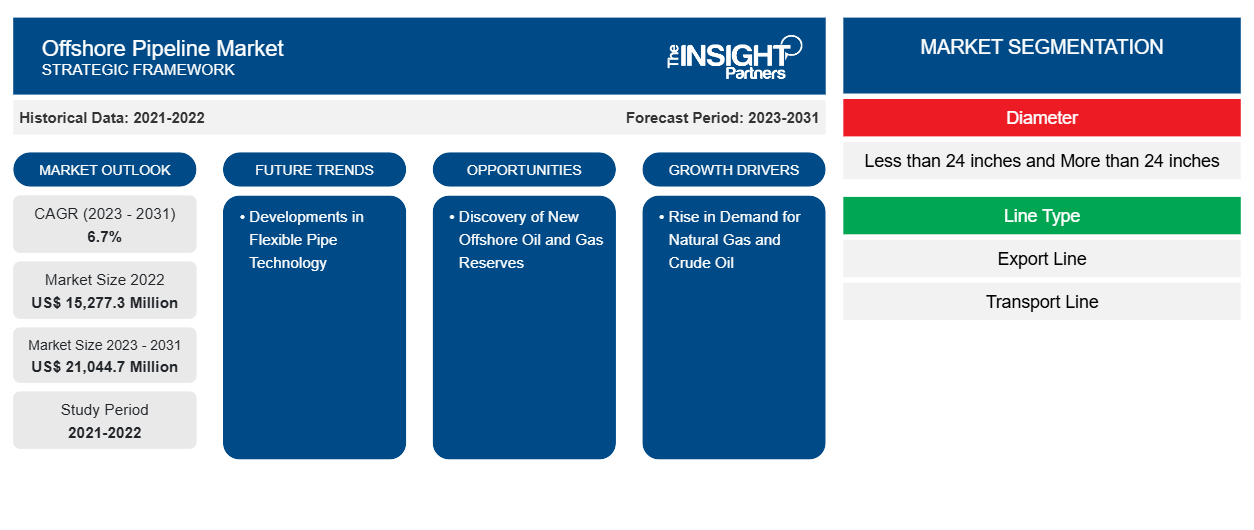Se proyecta que el tamaño del mercado de oleoductos en alta mar alcance los 21.044,7 millones de dólares en 2031, frente a los 15.277,3 millones de dólares en 2022. Se espera que el mercado registre una CAGR del 6,7 % durante el período 2023-2031. El aumento de la producción de petróleo y gas en alta mar, el aumento de la producción de nuevas plataformas petrolíferas y la reconstrucción de plataformas de petróleo y gas en alta mar existentes y antiguas se encuentran entre los factores clave que impulsan el mercado de oleoductos en alta mar.
Análisis del mercado de oleoductos en alta mar
Se espera que el mercado de los oleoductos en alta mar experimente un crecimiento considerable debido al creciente número de proyectos de gas natural, así como al descubrimiento de nuevos yacimientos petrolíferos, especialmente en lugares remotos. Además, el agotamiento de las reservas de petróleo y gas existentes en varios países ha creado una demanda de oleoductos transfronterizos para el suministro de productos relacionados con el petróleo y el gas, lo que está impulsando el crecimiento del mercado de oleoductos en alta mar. La creciente demanda de métodos de transporte rentables para el petróleo y el gas también es uno de los principales factores que se espera que impulsen la demanda de oleoductos en alta mar en el sector del petróleo y el gas en todo el mundo.
Panorama general del mercado de oleoductos offshore
La explosión demográfica y la correspondiente industrialización han disparado la demanda de energía a nivel mundial. El aumento del consumo de energía ha impulsado la necesidad de petróleo y gas en las economías en desarrollo y desarrolladas, lo que ha dado lugar a un aumento de la demanda de infraestructura de oleoductos en alta mar en todo el mundo. Asia Pacífico es el mayor consumidor de petróleo crudo y gas. Además, los países altamente industrializados de Asia Pacífico, incluidos China, India, Japón y Corea del Sur, están informando de un aumento del consumo general de energía. Su enfoque en el aumento de la producción nacional de petróleo mediante diversas técnicas mejoradas de recuperación de petróleo está promoviendo el mercado de oleoductos en alta mar en Asia Pacífico para satisfacer la creciente demanda de petróleo.
Personalice este informe según sus necesidades
Obtendrá personalización en cualquier informe, sin cargo, incluidas partes de este informe o análisis a nivel de país, paquete de datos de Excel, así como también grandes ofertas y descuentos para empresas emergentes y universidades.
-
Obtenga las principales tendencias clave del mercado de este informe.Esta muestra GRATUITA incluirá análisis de datos, desde tendencias del mercado hasta estimaciones y pronósticos.
Factores impulsores y oportunidades del mercado de oleoductos offshore
Aumento de la demanda de gas natural y petróleo crudo
La demanda de petróleo y gas natural está aumentando constantemente en todo el mundo. Estados Unidos y China han registrado el crecimiento más notable. El aumento de la producción industrial, junto con la alta demanda de servicios de transporte por carretera, está impulsando la demanda de productos petroquímicos, lo que alimenta el crecimiento del mercado de oleoductos en alta mar. Además, el crecimiento del volumen de tráfico aéreo en todo el mundo, especialmente en Asia, es otro factor significativo que provoca un aumento del consumo de petróleo.fuelling the growth of the offshore pipeline market. Moreover, the growth in air traffic volumes worldwide, particularly in Asia, is another significant factor resulting in increased oil consumption.
La Organización de Países Exportadores de Petróleo (OPEP) publicó “The 2020 OPEP World Oil Outlook” en octubre de 2020. Según las perspectivas, la pandemia de COVID-19 provocó una caída en la demanda de petróleo; sin embargo, se esperaba que la demanda mundial de energía registrara un crecimiento constante en el futuro, aumentando un notable 25% para 2045. Las perspectivas anticipan además que el petróleo será el mayor contribuyente en el mercado de la combinación energética, contribuyendo con el 27% de la participación energética general para 2045. Se estima que la demanda de productos derivados del petróleo aumentará en más de ~47 Mb/día durante 2022-2025 en los países de la OCDE. Por otro lado, se proyecta que la demanda en los países no pertenecientes a la OCDE aumentará en 22,5 MB/día durante el período de pronóstico.OECD countries. On the other hand, the demand in non-OECD countries is projected to rise by 22.5 MB/day during the forecast period.
Esfuerzos constantes para mejorar las operaciones de recuperación de petróleo
Varios países están invirtiendo en la revitalización de sus recursos petroleros existentes con el fin de impulsar la producción nacional de petróleo y reducir su dependencia de las importaciones de petróleo. En las últimas décadas, el método de inyección de vapor se ha explotado comercialmente para mejorar la recuperación de los yacimientos de petróleo pesado convencionales en sus últimas etapas de desarrollo. El vapor inyectado aumenta la presión general de un yacimiento de petróleo en alta mar, lo que ayuda a mejorar la relación de movilidad del petróleo crudo y le permite fluir de manera eficiente. Como resultado, los métodos mejorados de recuperación de petróleo ayudan a revitalizar los procesos de extracción en los pozos petrolíferos en alta mar existentes. Por lo tanto, se prevé que la expansión de las operaciones de petróleo y gas ofrezca oportunidades de crecimiento prometedoras para los actores del mercado de oleoductos en alta mar en los próximos años.
Análisis de segmentación del informe del mercado de oleoductos en alta mar
Los segmentos clave que contribuyeron a la derivación del análisis del mercado de ductos offshore son el tipo y el usuario final.
- Según el diámetro, el mercado de tuberías marinas se ha dividido en menos de 24 pulgadas y más de 24 pulgadas. El segmento de menos de 24 pulgadas tuvo una mayor participación de mercado en 2023.
- Por tipo de línea, el mercado de ductos offshore se segmenta en líneas de transporte, líneas de exportación y otras. El segmento de líneas de transporte tuvo la mayor participación de mercado en 2023.
- En términos de productos, el mercado está segmentado en petróleo, gas y productos refinados. El segmento de productos refinados dominó el mercado en 2023.
Análisis de la cuota de mercado de los oleoductos offshore por geografía
El alcance geográfico del informe del mercado de ductos offshore se divide principalmente en cinco regiones: América del Norte, Europa, Asia Pacífico, Medio Oriente y África, y América del Sur y Central.
En 2023, Europa dominó el mercado de los gasoductos en alta mar. El mercado en Europa está segmentado en Alemania, Noruega, Italia, Rusia, el Reino Unido y el resto de Europa. Europa es el segundo mayor productor de productos petrolíferos a nivel mundial y mantiene una capacidad de refinación de petróleo de más del 15 %. La industria del gas en Europa ha experimentado diversos cambios debido a la creciente demanda de GNL. Además, Noruega y Rusia aún mantienen su posición como proveedores de gas natural, mientras que Alemania, Francia e Italia son los principales importadores de gas natural. Por lo tanto, el creciente número de proyectos de gas natural, así como el descubrimiento de nuevos yacimientos petrolíferos, en particular en lugares remotos, muy probablemente acelerarán la demanda de sistemas y servicios de gasoductos en alta mar.
Perspectivas regionales del mercado de oleoductos offshore
Los analistas de Insight Partners explicaron en detalle las tendencias y los factores regionales que influyen en el mercado de oleoductos en alta mar durante el período de pronóstico. Esta sección también analiza los segmentos y la geografía del mercado de oleoductos en alta mar en América del Norte, Europa, Asia Pacífico, Oriente Medio y África, y América del Sur y Central.

- Obtenga datos regionales específicos para el mercado de oleoductos offshore
Alcance del informe sobre el mercado de oleoductos en alta mar
| Atributo del informe | Detalles |
|---|---|
| Tamaño del mercado en 2022 | US$ 15.277,3 millones |
| Tamaño del mercado en 2031 | US$ 21.044,7 millones |
| CAGR global (2023 - 2031) | 6,7% |
| Datos históricos | 2021-2022 |
| Período de pronóstico | 2023-2031 |
| Segmentos cubiertos |
Por diámetro
|
| Regiones y países cubiertos |
América del norte
|
| Líderes del mercado y perfiles de empresas clave |
|
Densidad de actores del mercado de oleoductos offshore: comprensión de su impacto en la dinámica empresarial
El mercado de oleoductos offshore está creciendo rápidamente, impulsado por la creciente demanda de los usuarios finales debido a factores como la evolución de las preferencias de los consumidores, los avances tecnológicos y una mayor conciencia de los beneficios del producto. A medida que aumenta la demanda, las empresas amplían sus ofertas, innovan para satisfacer las necesidades de los consumidores y aprovechan las tendencias emergentes, lo que impulsa aún más el crecimiento del mercado.
La densidad de actores del mercado se refiere a la distribución de las empresas o firmas que operan dentro de un mercado o industria en particular. Indica cuántos competidores (actores del mercado) están presentes en un espacio de mercado determinado en relación con su tamaño o valor total de mercado.
Las principales empresas que operan en el mercado de oleoductos offshore son:
- Enbridge Inc
- Saipem SpA
- Compañía: McDermott Internacional Ltda.
- Grupo Allseas SA
- Ingeniería de oleoductos de China Ltd.
- Niño Morgan
Descargo de responsabilidad : Las empresas enumeradas anteriormente no están clasificadas en ningún orden particular.

- Obtenga una descripción general de los principales actores clave del mercado de oleoductos en alta mar
Noticias y desarrollos recientes del mercado de oleoductos offshore
El mercado de oleoductos en alta mar se evalúa mediante la recopilación de datos cualitativos y cuantitativos a partir de una investigación primaria y secundaria, que incluye importantes publicaciones corporativas, datos de asociaciones y bases de datos. A continuación, se enumeran algunos de los avances en el mercado de oleoductos en alta mar:
- En julio de 2023, Kinder Morgan y Howard Energy Partners ampliaron sus sistemas de transporte de gas natural en Eagle Ford. Tejas está construyendo un gasoducto de 67 millas y Dos Caminos está construyendo un gasoducto de 62 millas. Se espera que los proyectos se completen en el cuarto trimestre de 2023 y suministren hasta 2 mil millones de pies cúbicos por día de gas natural a los mercados de la Costa del Golfo de EE. UU. El proyecto de expansión de US$ 251 millones es un enlace de suministro fundamental para generadores de energía , clientes industriales y exportadores de GNL a lo largo de la red de gasoductos intraestatales de Texas.
- En febrero de 2023, Enagás firmó un acuerdo con Reganosa por el que Enagás pagó 54 millones de euros a Reganosa para adquirir una red de 130 km de gasoductos de gas natural. De esta red depende el funcionamiento eficiente y la seguridad de suministro del mercado ibérico del gas.
Informe sobre el mercado de oleoductos en alta mar: cobertura y resultados
El informe “Tamaño y pronóstico del mercado de oleoductos en alta mar (2021-2031)” proporciona un análisis detallado del mercado que cubre las siguientes áreas:
- Tamaño y pronóstico del mercado de tuberías marinas a nivel mundial, regional y nacional para todos los segmentos clave del mercado cubiertos bajo el alcance
- Tendencias del mercado de oleoductos en alta mar, así como dinámica del mercado, como impulsores, restricciones y oportunidades clave
- Análisis detallado de las cinco fuerzas de Porter y PEST y FODA
- Análisis del mercado de tuberías marinas que abarca las tendencias clave del mercado, el marco global y regional, los principales actores, las regulaciones y los desarrollos recientes del mercado
- Análisis del panorama de la industria y de la competencia que abarca la concentración del mercado, el análisis de mapas de calor, los actores destacados y los desarrollos recientes del mercado de tuberías marinas
- Perfiles detallados de empresas
- Análisis histórico (2 años), año base, pronóstico (7 años) con CAGR
- Análisis PEST y FODA
- Tamaño del mercado, valor/volumen: global, regional y nacional
- Industria y panorama competitivo
- Conjunto de datos de Excel
Informes recientes
Testimonios
Razón para comprar
- Toma de decisiones informada
- Comprensión de la dinámica del mercado
- Análisis competitivo
- Información sobre clientes
- Pronósticos del mercado
- Mitigación de riesgos
- Planificación estratégica
- Justificación de la inversión
- Identificación de mercados emergentes
- Mejora de las estrategias de marketing
- Impulso de la eficiencia operativa
- Alineación con las tendencias regulatorias























 Obtenga una muestra gratuita para - Mercado de oleoductos offshore
Obtenga una muestra gratuita para - Mercado de oleoductos offshore